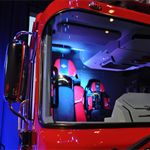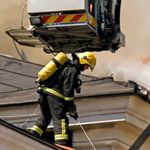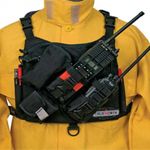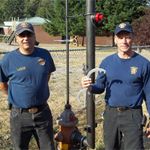The year 2014 was another good year for the development of products and apparatus that will help make the job of firefighters and fire officers safer, more effective, and more efficient in 2015 and for many years to come.
It’s interesting that the top five articles covered new products that were developed by firefighters for firefighters?
So, without further delay, here are the most read FireRescue1 product articles for the past year.
 | 10. Fire truck chassis gain leg, hip room Spartan Chassis increased the interior cab space in its Gladiator series of fire apparatus to 5,827 cubic inches to provide more room for the driver and officer. Without changing the 99-inch width chassis, Spartan increased the volume to 5,827 cubic inches. This breaks down to a 10 percent increase in hip room on driver’s side of tunnel; an 11 percent increase in hip room on officer’s side door to side of tunnel; a 6.6 percent reduction in tunnel height; and a 3.8 percent increase in leg room for the two center forward-facing crew members. Read more |
 | 9. How a new Florida fire station will pay for itself As part of our efforts at FireRescue1.com to promote sustainability and “green” construction features in new and existing fire department facilities, Battalion Chief (Ret.) Robert Avsec profiled several new fire stations across the USA, including this one in Florida. Fire Station 65 of the Deltona (Fla.) Fire Department was designed and built to be a fire station that helps pay its way. The $2 million, 11,000-square-foot fire station opened for service in August 2012 and has many green technologies that reduce its carbon footprint and save big dollars in operating costs each month. How did the fire department do it? They invested in 10 green technologies. Read more |
 | 8. Holy Grail of firefighter tracking on the horizon The technology involves sensor modules worn on a firefighter’s belt. The modules contain sensors such as accelerometers and barometers to produce location information and can often coordinate with one another in a mesh network to produce coordinate information. Software then distributes that snapshot of this information through the radio back to the command infrastructure. The sensor technology is improving far more rapidly than practical for radio upgrade cycles. While this sensor module locating system currently is only recommended for training purposes, it is just a matter of time before full deployment is possible. Read more |
 | 7. Three companies partner on more flexible firefighting glove Firefighters are constantly on the lookout for structural firefighting gloves that meet NFPA performance and protection standards and that provide them with the dexterity to carry out their job tasks. Designed by S&T’s First Responders Group (FRG) in conjunction with partners from Shelby Specialty Gloves and NanoSonic, the new structure glove will offer a full range of movement and protection from the elements firefighters need in the field. The new glove is in response to firefighter complaints to S&T engineers that current firefighter gloves were too bulky. Read more |
 | 6. Ten cool search-and-rescue tools Search-and rescue operations in remote wilderness locations or in urban situations following a natural or man-made disaster require specialized tools and equipment for the first responder. Here are 10 search-and-rescue tools and technologies that can improve a department’s operations and make them safer, more effective and more efficient. Read more |
 | 5. How to spend less on fire trucks Most of us have purchased a car or two in our lifetime. So, why is purchasing fire apparatus so different? Why doesn’t the process look a bit more like what we routinely use for purchasing our personal vehicles? I posed those questions, and a few others, to several of the major manufacturers and dealers of fire apparatus. Read more |
 | 4. Google Glass app arms firefighters with data Imagine an application that lets firefighters receive field data directly to a display inside an SCBA facemask. That’s exactly what Fire Engineer Patrick Jackson is developing with a new Google Glass-compatible version of his FirefighterLog mobile app that provides location and other data to firefighters. Jackson currently works as an engineer at the Rocky Mount (N.C.) Fire Department where he has the opportunity to marry his background of computer engineering and firefighting operations to develop the FirefighterLog app, available on iOS and Android devices as well. Read more |
 | 3. Firefighter invents roof operations safety tool Firefighter Derron Suchodolski, president of Practical Fire Equipment, saw a need for firefighters’ roof operations safety after his department experienced budget cuts. The Roof Operations Safety Platform provides a safe and solid place for your foot when you need to leave the safety of the ladder. We caught up with him to learn more about his product. Read more |
 | 2. Firefighter invents tool to conquer snowed-in hydrants Every year, three million fire hydrants are buried in more than 72 inches of snow. On average, it takes 20 minutes to dig and move to the next hydrant; the Hydrant Snorkel eliminates this problem. Lt. John Creel, creator of the Hydrant Snorkel and a retired 23-year veteran with the Hoodland (Ore.) Fire Department, found a way to establish water flow from hydrants deep under snow. Read more |
 | 1. Retired firefighter invents revolutionary fire hydrant And the #1 viewed product article on FireRescue1.com for 2014 came from one firefighter’s work that resulted in the reinvention of the fire hydrant. Retired firefighter George Sigelakis, founder and creator of the Sigelock Spartan Hydrant, saw a need to redesign the conventional fire hydrant after learning how easy it was to access them, steal water and damage the hydrant to the point of making it inoperable. Read more |











